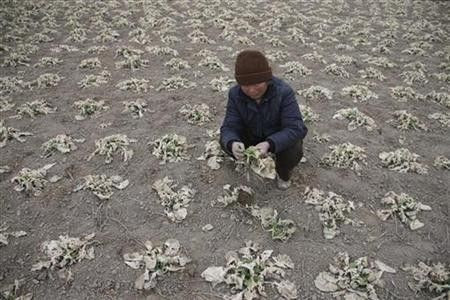China snows bring limited relief to drought-hit areas

Snow across some drought-hit parts of north and central China brought limited respite from a drought threatening winter wheat crops that has fueled talk of higher global prices, state forecasters said Thursday.
After the welcome, but still patchy, snowfalls, Premier Wen Jiabao sounded a confident note, saying that China would be able to produce enough grain and rein in inflation that has been driven by rising food prices.
Snow was recorded in the capital Beijing, and parts of Henan, Anhui and Jiangsu provinces, some of which have endured months without precipitation, Sun Jun, a senior forecaster for China's meteorological service told state radio.
Because the precipitation will be concentrated in the middle and lower reaches of the Yangtze River, it will have a limited effect on mitigating the drought in northern areas, said Sun.
Those northern areas include Henan and Shandong provinces, both big grain producers.
Data and images from the China Meteorological Administration showed patches of both provinces had snowfalls, but most areas stayed dry and were likely to remain so for the next two days at least (www.weather.com.cn).
Shandong was likely to receive additional snowfalls in the next four days, the Meteorological Administration reported.
But as the snowfalls will not be big, their contribution to easing the drought conditions will be of scant help, said a report on its website.
The snowfall in some drought-hit areas is forecast to gradually diminish until Sunday, Xinhua News Agency cited the National Meteorological Center as saying Thursday.
GLOBAL IMPORTANCE
China weighs heavily in calculations of global grain demand, and traders believe an erosion of the nation's self-sufficiency could ripple through the global wheat market, driving up prices.
This year, global supply and demand for grains is tight and the price rises have basically been worldwide, and so stabilizing grain production has become all the more important, Li Guoxiang, an agricultural economist at the Chinese Academy of Social Sciences, told the Economic Information Daily, a Chinese-language newspaper.
Premier Wen is also worried that any fall in grain output could magnify inflationary pressures, a big headache for policy-makers in Beijing with consumer prices rising at their fastest annual pace in nearly three years.
Maintaining stable growth in this year's grain production is extremely important for properly managing inflationary expectations, stabilizing the general level of consumer prices and achieving steady and relatively fast growth, as well as social harmony and stability, said the official report of a central government meeting chaired by Wen Wednesday.
In a teleconference Thursday, Wen was optimistic about China's prospects.
We have the confidence and capability to ensure efficient supply of agricultural products, particularly grain, and to keep overall price levels basically stable, he said.
China harvested 115.1 million metric tons in 2010, 95 percent of it winter wheat, the crop now at risk. Winter wheat is planted in October and harvested in May and June.
The drought has hit 7.7 million hectares of winter wheat growing areas across eight provinces, including Henan and Shandong, covering 42.4 percent of their total winter wheat acreage, the Ministry of Agriculture said.
Only 1.69 million hectares, about a fifth of the drought-hit acreage, was seriously affected, it said.
U.S. wheat futures have been near a 30-month high, buoyed by strong demand and worries about threats to output in China and the United States.
Chinese wheat futures rose by the 7.0 percent daily limit Wednesday after a week-long holiday. That rise came despite the latest hike in Chinese interest rates late on Tuesday, a policy measure seen to be partly aimed at food inflation, which hit 9.6 percent in the year to December.
More snow and rain may be on the way, although not necessarily in the regions most in need.
The national forecasting service predicted a cold front in coming days could bring small to moderate amounts of rain, snow and sleet to parts of northwest, northern and central China, the China News Service reported.
© Copyright Thomson Reuters 2024. All rights reserved.





















